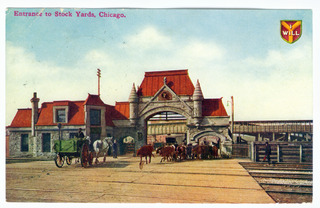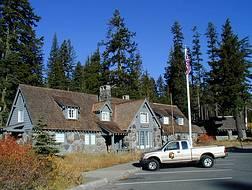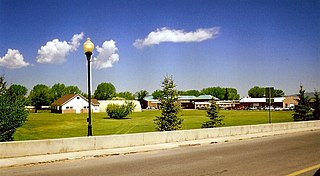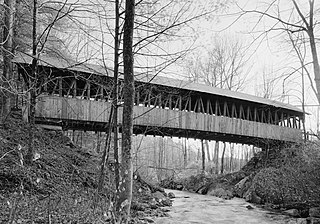
George Gordon Meade was a United States Army Major General who commanded the Army of the Potomac during the American Civil War from 1863 to 1865. He fought in many of the key battles of the Eastern theater and defeated the Confederate Army of Northern Virginia led by General Robert E. Lee at the Battle of Gettysburg.

The Andersonville National Historic Site, located near Andersonville, Georgia, preserves the former Andersonville Prison, a Confederate prisoner-of-war camp during the final fourteen months of the American Civil War. Most of the site lies in southwestern Macon County, adjacent to the east side of the town of Andersonville. The site also contains the Andersonville National Cemetery and the National Prisoner of War Museum. The prison was created in February 1864 and served until April 1865.

Oak Hill is a mansion and plantation located in Aldie, Virginia that was for 22 years a home of Founding Father James Monroe, the fifth U.S. President. It is located approximately 9 miles (14 km) south of Leesburg on U.S. Route 15, in an unincorporated area of Loudoun County, Virginia. Its entrance is 10,300 feet (3,100 m) north of Gilberts Corner, the intersection of 15 with U.S. Route 50. It is a National Historic Landmark, but privately owned and not open to the public.

Belle Meade Plantation, now officially titled Belle Meade Historic Site and Winery, is a historic farm established in 1807 in Nashville, Tennessee, built, owned, and controlled by five generations of the Harding-Jackson family for nearly a century. The farm, named "Belle Meade", grew to encompass 5,400 acres (22km2) at its zenith and required a labor force of 136 enslaved workers. The farm's centerpiece was a Greek revival mansion built in 1853. Belle Meade Farm gained a national reputation in the latter half of the 19th century for breeding of thoroughbred horse racing stock, notably a celebrated stallion, Iroquois. In the Civil War, when the Union Army took control of Nashville, the mansion was pillaged and looted by soldiers who spent weeks quartered there; the owner was imprisoned. In the aftermath, the plantation recovered, but with greatly reduced capacity. Roughly half of the enslaved persons returned as paid employees after the war and lived in their own homes nearby. After a financial downturn in 1893 and later the death of the owner and his heir, the estate was dismantled and sold in parcels in 1906.

The Union Stock Yard Gate, located on Exchange Avenue at Peoria Street, was the entrance to the famous Union Stock Yards in Chicago. The gate was designed by Burnham and Root around 1875, and is the only significant structural element of the stock yards to survive. It was designated a National Historic Landmark in 1981. The plaza surrounding the gate also includes the city's principal memorial to its firefighters.

Togus VA Medical Center is a facility operated by the United States Department of Veterans Affairs in Chelsea, Maine. The facility was built as a resort hotel, and housed Union veterans of the American Civil War prior to being converted to a veterans hospital. It was the first veterans facility developed by the United States government.

The University of Wisconsin Dairy Barn is a building located on the campus of the University of Wisconsin–Madison. Built in 1897, the building played an important role in the field of dairy science during the 20th century. It has been used both as a teaching facility and as a site for agricultural research. It is significant for its association with the single-grain experiment, performed from 1907 to 1911 by Stephen Babcock. The UW Dairy Barn was declared a National Historic Landmark in 2005.

Munson Valley Historic District is the headquarters and main support area for Crater Lake National Park in southern Oregon. The National Park Service chose Munson Valley for the park headquarters because of its central location within the park. Because of the unique rustic architecture of the Munson Valley buildings and the surrounding park landscape, the area was listed as a historic district on the National Register of Historic Places (NRHP) in 1988. The district has eighteen contributing buildings, including the Crater Lake Superintendent's Residence which is a U.S. National Historic Landmark and separately listed on the NRHP. The district's NRHP listing was decreased in area in 1997.

The Georgia State Railroad Museum is a museum in Savannah, Georgia located at a historic Central of Georgia Railway site. It includes parts of the Central of Georgia Railway: Savannah Shops and Terminal Facilities National Historic Landmark District. The complex is considered the most complete antebellum railroad complex in the United States. The museum, located at 655 Louisville Road, is part of a historic district included in the National Register of Historic Places.

Pennsylvania Hall is the Gettysburg College central administrative building and the college's oldest building. Designed in 1835 by John Cresson Trautwine, it was built in 1838 as a "temple-style edifice with four columns in the portico".

The Wyoming State Hospital, once known as the Wyoming State Insane Asylum, is located in Evanston, Wyoming, United States. The historic district occupies the oldest portion of the grounds and includes fifteen contributing buildings, including the main administrative building, staff and patient dormitories, staff apartments and houses, a cafeteria and other buildings, many of which were designed by Cheyenne, Wyoming architect William Dubois. Established in 1887, the historic buildings span the period 1907-1948. At one point it was common for new hall additions to be named after the counties in Wyoming. The recent addition of Aspen, Cottonwood, and Evergreen halls do not follow this trend.

The Calumet and Hecla Industrial District is a historic district located in Calumet, Michigan and roughly bounded by Hecla & Torch Lake Railroad tracks, Calumet Avenue, Mine and Depot Streets. The district contains structures associated with the copper mines worked by the Calumet and Hecla Mining Company, located along a line above the copper lode, where railroad tracks connected separate mine heads. The Historic District is completely contained in the Calumet Historic District and the Keweenaw National Historical Park. It was designated a Michigan State Historic Site in 1973 and was listed on the National Register of Historic Places in 1974.

The George Gordon Meade Memorial, also known as the Meade Memorial or Major General George Gordon Meade, is a public artwork in Washington, D.C. honoring George Meade, a career military officer from Pennsylvania who is best known for defeating General Robert E. Lee at the Battle of Gettysburg. The monument is sited on the 300 block of Pennsylvania Avenue NW in front of the E. Barrett Prettyman United States Courthouse. It was originally located at Union Square, but was removed and placed in storage for fourteen years before being installed at its current location. The statue was sculpted by Charles Grafly, an educator and founder of the National Sculpture Society, and was a gift from the state of Pennsylvania. Prominent attendees at the dedication ceremony in 1927 included President Calvin Coolidge, Governor John Stuchell Fisher, Secretary of the Treasury Andrew W. Mellon, and Senator Simeon D. Fess.

The El Tovar Stables at the south rim of the Grand Canyon were built about 1904, at the same time the nearby El Tovar Hotel was built, to house the animals used in general transportation around the park. Collectively called the "transportation department" in the early 20th century, the three structures comprised a horse barn or stable, a mule barn and a blacksmith shop.

The Wyoming Territorial Prison is a former federal government prison near Laramie, Wyoming. Built in 1872, it is one of the oldest buildings in Wyoming. It operated as a federal penitentiary from 1872 to 1890, and as a state prison from 1890 to 1901. It was then transferred to the University of Wyoming and was used as an agricultural experiment station until 1989. In 1991, the facility was opened to the public, and in 2004, it was designated as Wyoming Territorial Prison State Historic Site.

The Kenyon Bridge, also known as the Blacksmith Shop Bridge, is a historic covered bridge spanning Mill Brook near Town House Road in Cornish, New Hampshire, United States. Built in 1882, it is one of New Hampshire's few surviving 19th-century covered bridges. It was listed on the National Register of Historic Places in 1978.
The J.D. Craven Women's Relief Corps Hall is a historic building located in Macksburg, Iowa, United States. The J. D. Craven Post #198 of the Grand Army of the Republic (GAR) was organized in 1883. They organized an auxiliary, the J.D. Craven Post #322 of the Women's Relief Corps (WRC), in 1898. They built this two-story frame building in 1901 with donated labor and lumber. It is a rare example of a vaulted roof commercial building. In addition to the functions of the WRC, the building has also served as a community building. It also housed the local public school during the 1920–21 school year when their new building was under construction. The WRC continued in existence, even after the GAR folded. When the hall was nominated for National Register of Historic Places, the J.D. Craven Post was still in existence. It was the only one left in Madison County, and one of 34 in Iowa at that time. They added seasonal assistance to the elderly to their aid for veterans. The building was listed on the National Register in 1984.
The Huxtable Ranch Ranch Headquarters District, also known as White Creek Ranch, comprises a complex of ranch structures in Converse County, Wyoming. It was part of a dispersed community known as Boxelder, established by settlers in the 1880s. The ranch was established in 1893 by Charles Smith who built a one-room and later a three-room cabin on the property, as well as a barn. Three years later he sold the homestead to Willard Heber White. White and his wife lived on the ranch until 1928 when they moved to Douglas. On White's death in 1929, the ranch was purchased by Lloyd Huxtable and Charlie Olin. Lloyd and Olin built the present ranch house for Charlie and his wife Najima, Olin's sister, from 1933 to 1935. The Huxtables operated the ranch until his death at 86 in 1976. Huxtable served as a Converse County Commissioner from 1948 to 1956.
The Circle Cross Ranch Headquarters, in Otero County, New Mexico, near Sacramento, New Mexico, was partly built in 1906. It was listed on the National Register of Historic Places in 1980. It has also been known as the Oliver M. Lee House and Ranch.



















